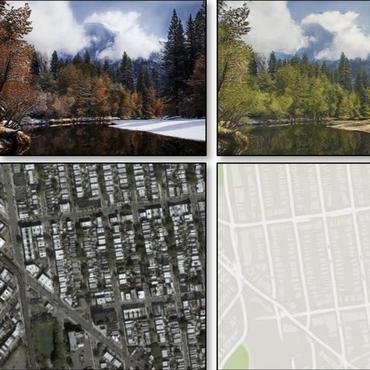Unsupervised Image-To-Image Translation
69 papers with code • 2 benchmarks • 2 datasets
Unsupervised image-to-image translation is the task of doing image-to-image translation without ground truth image-to-image pairings.
( Image credit: Unpaired Image-to-Image Translation using Cycle-Consistent Adversarial Networks )
Libraries
Use these libraries to find Unsupervised Image-To-Image Translation models and implementationsLatest papers with no code
Closing the Reality Gap with Unsupervised Sim-to-Real Image Translation
Deep learning approaches have become the standard solution to many problems in computer vision and robotics, but obtaining sufficient training data in high enough quality is challenging, as human labor is error prone, time consuming, and expensive.
Mocycle-GAN: Unpaired Video-to-Video Translation
Unsupervised image-to-image translation is the task of translating an image from one domain to another in the absence of any paired training examples and tends to be more applicable to practical applications.
Combining Noise-to-Image and Image-to-Image GANs: Brain MR Image Augmentation for Tumor Detection
In this context, Generative Adversarial Networks (GANs) can synthesize realistic/diverse additional training images to fill the data lack in the real image distribution; researchers have improved classification by augmenting data with noise-to-image (e. g., random noise samples to diverse pathological images) or image-to-image GANs (e. g., a benign image to a malignant one).
Joint haze image synthesis and dehazing with mmd-vae losses
Fog and haze are weathers with low visibility which are adversarial to the driving safety of intelligent vehicles equipped with optical sensors like cameras and LiDARs.
Unsupervised one-to-many image translation
We perform completely unsupervised one-sided image to image translation between a source domain $X$ and a target domain $Y$ such that we preserve relevant underlying shared semantics (e. g., class, size, shape, etc).
TransGaGa: Geometry-Aware Unsupervised Image-to-Image Translation
Extensive experiments demonstrate the superior performance of our method to other state-of-the-art approaches, especially in the challenging near-rigid and non-rigid objects translation tasks.
Semantics-Aware Image to Image Translation and Domain Transfer
Image to image translation is the problem of transferring an image from a source domain to a different (but related) target domain.
Semi-Supervised Image-to-Image Translation
The advantage of using such an approach is that the image-to-image translation is semi-supervised, independant of image segmentation and inherits the properties of generative adversarial networks tending to produce realistic.
Latent Filter Scaling for Multimodal Unsupervised Image-to-Image Translation
In multimodal unsupervised image-to-image translation tasks, the goal is to translate an image from the source domain to many images in the target domain.
Unsupervised Image-to-Image Translation Using Domain-Specific Variational Information Bound
These approaches usually fail to model domain-specific information which has no representation in the target domain.



 MNIST
MNIST
 Freiburg Forest
Freiburg Forest
